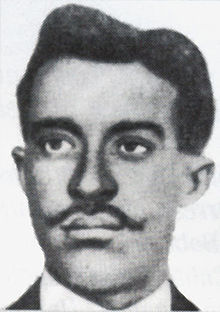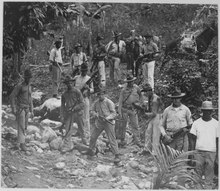Charlemagne Péralte
François Borgia Charlemagne Péralte , also known as Charlemagne Masséna Péralte (born October 10, 1885 in Hinche , † November 1, 1919 in Grand-Rivière du Nord , Haiti) was a Haitian military , politician and guerrilla . He was killed in action with US Marines during the US intervention in Haiti from 1915 to 1934 .
Life
origin
Péraltes father was the Dominican general Remi Masséna Peralta. Péralte attended a French lycée and in 1915, as a general in the Haitian army, was the military chief of the city of Léogane. He was a brother-in-law of the former President Oreste Zamor and sympathized with the exiled politician Rosalvo Bobo , who was in Jamaica .
Resistance to US occupation
With the establishment of the American occupation and the dissolution of the Haitian army, Péralte refused to enter American service.
To maintain the occupation, the Marine Corps founded the Gendarmerie d'Haiti in December 1915 , which was temporarily commanded by Major Smedley D. Butler with the rank of Major General of Haiti . In 1916 Butler introduced the system des corvée ; a kind of forced labor system analogous to forced labor to accelerate the construction of roads and public buildings. This system aroused considerable resistance from the population. In this context, Péralte planned an attack on a gendarmerie post in Hinche, was arrested and sentenced to five years of forced labor. On September 3, 1918, he managed to escape by persuading his guard to flee with him.
Péralte found the support of cacos ; irregular gangs that had been active in northern Haiti in previous civil wars and were consistently referred to as bandits by the Americans . Péraltes strategic political and military goal was the end of the occupation rule. On October 17, 1918 , he carried out a first attack on the gendarmerie and marines in Hinche, but lost 35 followers and had to withdraw. On November 10th he managed to attack the gendarmerie post in Maissade. The city was captured and the post destroyed.
In the spring of 1919 Péralte had a good 5000 cacos and thousands of civilian helpers. The gendarmerie was no longer able to put down the insurrection on their own and requested support from the Marine Corps . In late March 1919, the gendarmerie received support from Marines from the Guantanamo Bay Naval Base , Cuba . In addition, 13 aircraft were also used. A good 500 cacos had been killed by July 1919 , but Péraltes units continued to control the rural regions of northern Haiti. At dawn on October 6, 1919, Péralte attacked the capital Port au Prince with 300 cacos . The attack was a fiasco and was stopped within minutes by the gendarmerie and marines with machine guns . Péraltes base camp was destroyed in pursuit of the attackers, but his arrest was unsuccessful.
Marine Sergeant Herman H. Hanneken (1893–1986) then developed a plan to arrest Péraltes, which was approved by Butler's successor as chief of the gendarmerie, Lieutenant Colonel Frederic May "Dopey" Wise. Hanneken bribed the former Caco general Jean Baptiste Conzé with $ 2000 , who then placed himself under Péralte with an alleged Caco troop. Hanneken and the Navy Private Button disguised themselves as cacos and marched with Conzé's troops into the Péraltes camp in Grand Revière du Nord on the night of November 1, 1919.
Hanneken shot the apparently completely surprised Péralte with his Colt pistol . Hanneken and Button then fought with Conzé's supporters against Péralte's bodyguard and transported his body out of the camp on a mule . The body was taken by train to Cap Haïtien , where it was identified by a priest .
Péralte's body has been publicly exhibited and photographed, and the image was distributed throughout Haiti for propaganda purposes . For the liquidation of Péraltes, Hanneken and Button received the Medal of Honor . 163 cacos were killed and 300 captured in the battle . The Caco uprising in northern Haiti ended with the death of Péraltes. It was continued south of Hinche by his deputy Benoît Batraville until he was shot on May 18, 1920 by a marines patrol .
Culture of remembrance
Apparently in 1935 the body was reburied on the orders of President Sténio Vincent and reburied in a national memorial service. There is a bust of Péraltes on the still existing grave.
In the 1990s, the 5 centimes coin of the Haitian currency showed Péraltes' portrait .
In Haitian literature, Charlemagne Péralte became a legendary, at times mythical figure. A biography is still not available.
literature
- Alan McPherson: The invaded. How Latin Americans and their allies fought and ended US occupations , Oxford u. a. (Oxford University Press) 2014. ISBN 978-0-19-534303-8
- Alan McPherson: A short history of US interventions in Latin America and the Caribbean , Chichester, West Sussex, UK / Malden, MA (Wiley-Blackwell) 2016. ISBN 978-1-118-95399-0 . ISBN 978-1-118-95400-3
- Ivan Musicant: The Banana Wars. A History of the United States Military Intervention in Latin America from the Spanish-American War to the Invasion of Panama. New York 1990, ISBN 0-02-588210-4 , pp. 212-219.
- Robert D. Heinl, Nancy Heinl: Written in Blood: The Story of the Haitian People, 1492–1971. Boston 1978, ISBN 0-395-26305-0 .
- Lester D. Langley: The Banana Wars. United States Intervention in the Caribbean, 1898-1934. Lexington, KY 1985, ISBN 0-8131-1548-5 .
- United States Marine Corps (USMC). In: Ian FW Beckett: Encyclopedia of Guerilla Warfare. New York 2001, ISBN 0-8160-4601-8 , pp. 246-248.
- Hans Christoph book : The wedding of Port-au-Prince , Frankfurt am Main (Suhrkamp) 1984. ISBN 3-518-04576-8
Web links
Footnotes
- ↑ Yanick Lahens : Dance of the Ancestors . Rotpunktverlag, Zurich 2004. ISBN 3-85869-271-9 . P. 22.
| personal data | |
|---|---|
| SURNAME | Péralte, Charlemagne |
| ALTERNATIVE NAMES | Péralte, François Borgia Charlemagne (full name); Péralte, Charlemagne Masséna (full name) |
| BRIEF DESCRIPTION | Haitian military, politician and guerrillero |
| DATE OF BIRTH | October 10, 1885 |
| PLACE OF BIRTH | Hinche , Haiti |
| DATE OF DEATH | November 1, 1919 |
| Place of death | Grand-Rivière du Nord , Haiti |


